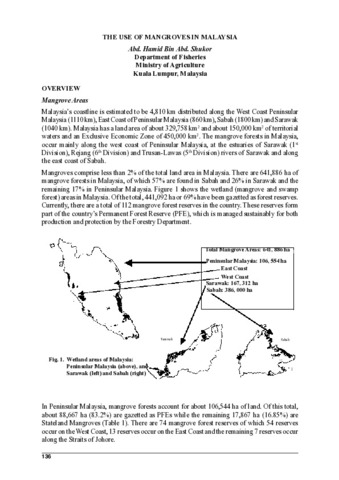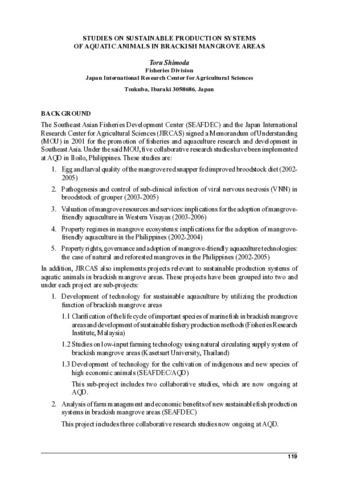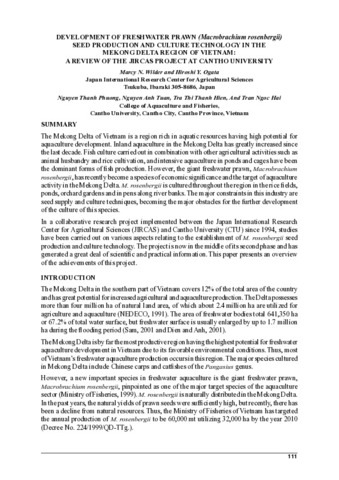Promotion of Mangrove-Friendly Shrimp Aquaculture in Southeast Asia
Browse by
Report on the Regional Seminar-Workshop on Mangrove-Friendly Shrimp Aquaculture 24-27 June 2003, Bangkok, Thailand.
Since 1998, AQD has already implemented a five-year program on Mangrove-Friendly Aquaculture addressing not only shrimps but also other aquaculture species such as grouper, mangrove red snapper, mud crab, etc. This was intended to investigate ways of harnessing degraded mangrove areas for aquaculture using environment-friendly approach, and to develop sustainable aquaculture in existing mangrove areas.The progress of the program was however, overtaken by a series of events that led to a slight change of focus. During the First FCG Meeting in March 1999, the Program on the Promotion of Mangrove-Friendly Aquaculture in Southeast Asia was approved under the FCG collaborative mechanism to be funded through the Trust Fund of the Fisheries Agency of the Government of Japan. The ensuing Twenty-Second Meeting of the SEAFDEC Program Committee in November 1999 endorsed to the FCG a revised framework for the Program on the Promotion of Mangrove-Friendly Aquaculture in Southeast Asia giving more focus on shrimp culture. Thus, the Mangrove-Friendly Shrimp Culture Project, which evolved from the AQD’s program, was initiated in 2000 adopting four major approaches: verification and pilot demonstration, research, training and information dissemination through publications.
The experiences in shrimp culture in Thailand and the Philippines served as basis for the initial technology verification and demonstration activities of the Project. These experiences were documented in the form of state-of-the-art compilations on environment-friendly shrimp farming intended to serve as guide for shrimp growers in the region. These compilations were later updated and produced into a Manual describing environment-friendly shrimp culture method using two systems: low-discharge and closed recirculating. Using these two systems, verification and demonstration activities have been conducted in the Philippines, Thailand, Vietnam and Myanmar with remarkable success. The successful results obtained from the current verification and demonstration activities in the aforementioned countries have encouraged other countries to express their desire for similar verification runs. During the later part of 2003, a pilot demonstration activity was started in Cambodia. In addition, initial efforts were also made in November 2003 for the conduct of a similar demonstration activity in Malaysia.
Download the complete report.Recent Submissions
-
Use of mangroves for aquaculture: Vietnam.
(Aquaculture Department, Southeast Asian Fisheries Development Center, 2004)Vietnam has a coastal line of 3600 km with a large wetland (tidal area) area of 600,000 ha (according to the survey statistics of the Institute of Planning and Economics under the Ministry of Fisheries), in which mangrove ... -
Mitigation plan on the use of mangroves for aquaculture: Thailand.
(Aquaculture Department, Southeast Asian Fisheries Development Center, 2004)Mangrove forest is one of the important coastal natural resources of Thailand, however, mangrove forests have deteriorated very rapidly at a rate of more than 50% of the mangrove loss during 1961–1996. The utilization and ... -
The use of mangroves for aquaculture: Philippines
(Aquaculture Department, Southeast Asian Fisheries Development Center, 2004)According to the National Forest Resource Inventory (NFRI), the estimated remaining area of mangrove forests in the Philippines in 1988 is 139,100 ha (DENR 1994). Of the total 139,100 ha mangrove forests, 78,593 ha are ... -
Use of mangroves for aquaculture: Myanmar.
(Aquaculture Department, Southeast Asian Fisheries Development Center, 2004)Aquaculture has only started to develop rapidly in the past few decades, due to better knowledge of culture species, improved methodologies and techniques in breeding, nutrition and increasing demand for food fish of ... -
The use of mangroves in Malaysia
(Aquaculture Department, Southeast Asian Fisheries Development Center, 2004) -
The use of mangroves for aquaculture: Indonesia.
(Aquaculture Department, Southeast Asian Fisheries Development Center, 2004)Indonesia has more than 17,500 islands and 81,000 km of coastline which bears the biggest mangrove area in the world, based on the data given by a source in 1982, which stated that mangrove areas was 4.25 million ha or 27 ... -
The use of mangroves for aquaculture: Cambodia.
(Aquaculture Department, Southeast Asian Fisheries Development Center, 2004)Natural conditions of the coastal and ecosystems of Cambodia have made this country rich of biodiversity resources. Cambodia’s 435 km coastline is covered with large estuaries with about 85,100 ha of mangrove forests (Nelson ... -
Shrimp culture and mangroves: Brunei Darussalam.
(Aquaculture Department, Southeast Asian Fisheries Development Center, 2004)Brunei Darussalam is a coastal state located in the north-western portion of Borneo island within latitudes 5o 05’ N and 4o 00’ N and longitudes 114o 04’ E and 115o 22’ E. The country has a land area of 5765 km2 (576,400 ... -
Studies on sustainable production systems of aquatic animals in brackish mangrove areas.
(Aquaculture Department, Southeast Asian Fisheries Development Center, 2004)The Southeast Asian Fisheries Development Center (SEAFDEC) and the Japan International Research Center for Agricultural Sciences (JIRCAS) signed a Memorandum of Understanding (MOU) in 2001 for the promotion of fisheries ... -
Development of freshwater prawn (Macrobrachium rosenbergii) seed production and culture technology in the Mekong Delta Region of Vietnam: A review of the JIRCAS Project at Cantho University.
(Aquaculture Department, Southeast Asian Fisheries Development Center, 2004)The Mekong Delta of Vietnam is a region rich in aquatic resources having high potential for aquaculture development. Inland aquaculture in the Mekong Delta has greatly increased since the last decade. Fish culture carried ... -
Transboundary movement of exotic shrimp species in the Asian region.
(Aquaculture Department, Southeast Asian Fisheries Development Center, 2004)This compiled information were based on presentations at the AQUAMARKET Shrimp Session in Manila, Philippines, 2-6 June 2003, made by T.W. Flegel (BIOTEC), C.V. Mohan (NACA), P. Chanratchakool (AAHRI), and C.R. Lavilla-Torres ... -
Training course on mangrove-friendly shrimp aquaculture.
(Aquaculture Department, Southeast Asian Fisheries Development Center, 2004)The culture of shrimps is a worldwide multi-dollar industry that experienced a phenomenal growth in the early eighties. Thereafter, growth was modest due to the advent of diseases and the rise of environment advocacy. One ... -
Capacity of mangroves to process shrimp pond effluents.
(Aquaculture Department, Southeast Asian Fisheries Development Center, 2004)Shrimp culture has been criticized for causing mangrove loss and discharging effluents laden with chemicals, organic matter and nutrients into waterways. Hence the SEAFDEC Council mandated SEAFDEC/AQD to undertake studies ... -
Nutrient cycles: Nutrient dynamics in culture ponds.
(Aquaculture Department, Southeast Asian Fisheries Development Center, 2004)The general over-development of aquaculture had profound disturbance on the surrounding ecosystem, affecting, not only fisheries, but aquaculture itself through release of effluent loaded with nutrients into open waters ... -
Verification of semi-intensive shrimp culture techniques: Myanmar.
(Aquaculture Department, Southeast Asian Fisheries Development Center, 2004)In the year 2000, the Ministry of Livestock and Fisheries reinforced and encouraged many potential investors to be involved in the shrimp aquaculture development in the country. At the same time, the Union of Myanmar formed ... -
Verification of semi-intensive shrimp culture techniques: Vietnam.
(Aquaculture Department, Southeast Asian Fisheries Development Center, 2004)Vietnam has about 260,000 ha devoted for shrimp culture in early 1999. The total production was estimated at about 80,000 tons in 2000, so that productivity was about 300 kg/ha only. In 1990–1997, vast areas of mangroves ... -
Mitigation measures of effluents from shrimp farms on mangrove and coastal resources.
(Aquaculture Department, Southeast Asian Fisheries Development Center, 2004)More than 80 % of shrimp production of Phuket comes from small-scale intensive farms. Most of shrimp farms use direct supply of seawater from the open sea and released effluents to canals. The effect of the unlimited ... -
Evaluation of seawater irrigation for intensive marine shrimp farming.
(Aquaculture Department, Southeast Asian Fisheries Development Center, 2004)The seawater irrigation system has benefited the intensive marine shrimp culture making shrimp culture sustainable and increasing shrimp production. The results obtained from this research study indicated that the adverse ... -
Integrated physical and biological technologies for water recycling in shrimp farms.
(Aquaculture Department, Southeast Asian Fisheries Development Center, 2004)Environment-friendly shrimp culture system has been an issue for improving shrimp farming and making it sustainable. In the past decade, Thailand adopted the open shrimp culture system, which consumed a lot of coastal and ... -
Mangrove plantation for enhancing food web in water recycling shrimp farms.
(Aquaculture Department, Southeast Asian Fisheries Development Center, 2004)Environmental deterioration in ponds and costal waters has been a common evidence after each intensive shrimp culture due to the accumulation of organic wastes and occurrence of eutrophication processes. Mangrove is a ...





















